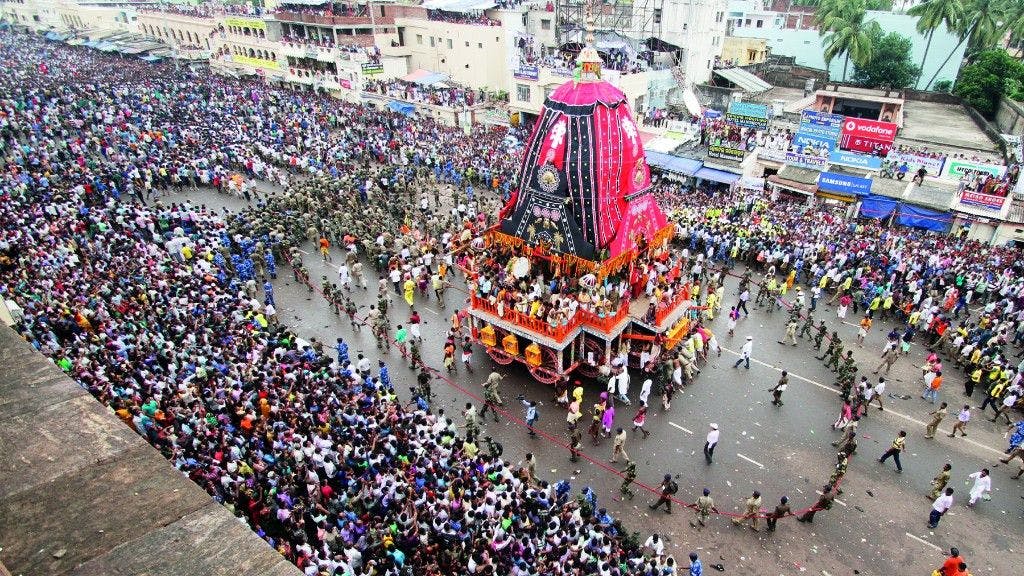Jagannath’s Ratha Yatra
BOOKMARK
The annual Ratha Yatra of Jagannath at Puri has been well-covered nationally and internationally in books, magazines and documentary films. In fact, so popular is it, that even the word ‘Juggernaut’ in the English language (to signify a large overwhelming force or group), traces its roots to this mega festival. So when you begin reading a book on the Ratha Yatra, it is natural to wonder, what new you can learn.
You will be pleasantly surprised when you pick up the book Ratha Yatra, Chariot Festival of Sri Jagannatha at Puri by author Subhas Pani. Published by Niyogi Books , this coffee table book moves beyond the obvious. It looks at the sacred town of Puri, the various communities associated with the temple built by King Anantavarma Chodaganagadeva (1078-1147 CE) , and how the Yatra is just one link in a series of festivals, connected with Lord Jagannatha.
– The English word ‘Juggernaut’ traces its roots to this festival
The author Subhas Pani, a former civil servant, served as a commentator for the national and international broadcast of the Rath Yatra for India’s National broadcaster Doordarshan for more than two decades. This gave him a unique birds eye view into the event and insights into the intricate rituals and ceremonies accompanying the Ratha Yatra. The book begins with an introduction to Sri Jagannatha, and then takes a look at the temple-town, different festivals celebrated there, the making of the chariots and the actual Yatra and rituals associated with it.
Interestingly Pani’s book reveals how the very representation of the main deities, Krishna and his siblings Subhadra and Balabhadra in the iconic and unique wooden form that you see at Jagannatha temple has roots in the iconography of the tribal communities here. In fact Krishna as Jagannatha can be traced to ‘Nilamadhava’, the deity of the Savara tribe, a former hunting tribe that occupied large parts of Odisha.
Even today, the wood from which the main images of the deities are created, comes from the tribal forests of Daspalla. This tribal connection and incorporation of their rituals, in the worship of Jagannatha, comes across strongly in the book.
Another interesting revelation is that the layout of the temple town of Puri and its sacred spots, is in shape of a sankha or conch, one of the four emblems of Vishnu. This is why Puri is also called ‘Sankha Kshetra’. Apart from the main temple, there are numerous other scared spaces in the town. The most prominent of these is the Gundicha temple, which is considered the birthplace of Jagannatha. The Ratha Yatra is the journey of the deities to the place of their birth and back. Interestingly, the Ratha Yatra is not a festival in isolation, but is a part of a series of interlinking festivals which all finally culminate in the grand Juggernaut - the Ratha Yatra!
– Puri is also called ‘Sankha Kshetra’ because it is laid out in the shape of a Sankha or conch, an object closely associated with Lord Vishnu.
The Ratha Yatra of Jagannatha goes back to the time of when the temple was built by Anantavarma Chodaganagadeva in the 11th century CE, and weaves in different hereditary communities connected to the temple. For instance, there is a community known as Supakaras or traditional cooks whose duty it is to prepare the Chappan bhoga or 56 types of offerings at the temple. Vishwakarma Sevakas arehereditary carpenters who make the chariots on which the Yatra takes place, while a community called Kamara Kanta Nayakas are a the ironsmiths, who makes special nails, pins and clamps for the chariot. Many such communities work together, behind the scenes, for the Ratha Yatra.
Subhas Pani’s book Ratha Yatra is a good read for someone who wants to understand the temple town, the communities and the intricate and detailed rituals that culminate in the Ratha Yatra.









